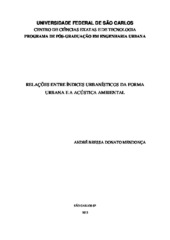| dc.contributor.author | Mendonça, André Bressa Donato | |
| dc.date.accessioned | 2016-06-02T20:00:54Z | |
| dc.date.available | 2013-12-05 | |
| dc.date.available | 2016-06-02T20:00:54Z | |
| dc.date.issued | 2013-11-20 | |
| dc.identifier.citation | MENDONÇA, André Bressa Donato. Relações entre índices urbanísticos da forma urbana e a acústica ambiental. 2013. 151 f. Dissertação (Mestrado em Ciências Exatas e da Terra) - Universidade Federal de São Carlos, São Carlos, 2013. | por |
| dc.identifier.uri | https://repositorio.ufscar.br/handle/ufscar/4368 | |
| dc.description.abstract | Noise pollution in urban areas has been an usual problem in several Brazilian cities. However, this issue does not take into account the urban morphology and its constant changes. Therefore, sound mapping is a helping tool on the matter, allowing the prevention of sound impacts and the recognition of areas under acoustic conflicts. Applying this planning instrument, this research aims at the identification of relations between indexes of urban form and sound pressure levels achieved on street networks, specifically when considering the potential offered by the occupancy rate, the floor space index and the ratio between height and width of the urban roads. The methodology is based on the collection of physical and acoustical data, on the application of a calculation model, named NMPB-Routes 2008 and its respective validation, and on the simulation of a future scenario in the acoustic software CADNA-A. The analyzes were based on the variations of sound pressure levels, which were verified between the current scenario and the future scenario, together with the identification of the relationships between the occupancy rate, the floor space index and the H/W factor, besides the classification of the acoustics conditions of the urban blocks. The results showed that the new buildings of the future scenario contributed up to 1.0 dB (A) in the increase of the sound pressure levels at the height of ten meters above ground level. Furthermore, among the factors studied at the height of four meters, the occupancy rate is the one assuming the highest importance on the increase of sound pressure levels. On the other hand, at ten meters-high, the floor space index achieved the greatest significance in the role played on the increment of noise levels. | eng |
| dc.description.sponsorship | Financiadora de Estudos e Projetos | |
| dc.format | application/pdf | por |
| dc.language | por | por |
| dc.publisher | Universidade Federal de São Carlos | por |
| dc.rights | Acesso Aberto | por |
| dc.subject | Planejamento urbano | por |
| dc.subject | Índices urbanísticos | por |
| dc.subject | Acústica arquitetônica | por |
| dc.subject | Mapeamento sonoro | por |
| dc.subject | Acústica ambiental | por |
| dc.subject | Urban index | eng |
| dc.subject | Environmental acoustics | eng |
| dc.subject | Urban planning | eng |
| dc.subject | Sound
mapping | eng |
| dc.title | Relações entre índices urbanísticos da forma urbana e a acústica ambiental | por |
| dc.type | Dissertação | por |
| dc.contributor.advisor1 | Souza, Lea Cristina Lucas de | |
| dc.contributor.advisor1Lattes | http://lattes.cnpq.br/0083847008256434 | por |
| dc.description.resumo | A poluição sonora no meio urbano tem sido um problema recorrente em muitas cidades brasileiras. Entretanto, esta problemática não leva em consideração a morfologia urbana e suas constantes modificações. Para isso, o mapeamento sonoro é uma ferramenta de grande auxílio, que permite prevenir impactos sonoros e diagnosticar áreas com conflitos acústicos já existentes. Aplicando esse recurso, essa pesquisa tem por objetivo identificar relações entre índices urbanísticos da forma urbana e os níveis de pressão sonora alcançados em redes viárias, considerando especificamente o potencial oferecido pela taxa de ocupação, índice de aproveitamento e relação entre altura e largura das vias. A metodologia é baseada em levantamento de dados físicos e acústicos do local, aplicação de um modelo de cálculo denominado NMPB-Routes 2008 e sua respectiva validação, além da simulação de um cenário futuro no software acústico CADNA-A. As análises se basearam nas variações dos níveis de pressão sonora, que foram verificadas entre o cenário atual e o cenário futuro, com a identificação das relações entre os coeficientes de ocupação, aproveitamento e da relação H/W; e, a classificação acústica das quadras urbanas. Os resultados apontaram que as novas edificações do cenário futuro contribuem com um incremento de até 1,0 dB(A) nos níveis de pressão sonora para a altura de dez metros acima do nível do solo. Verificouse também que, dentre os coeficientes estudados, o coeficiente de ocupação assume importância maior para a altura de quatro metros, influenciando no incremento dos níveis sonoros. Para alturas a dez metros acima do solo, o coeficiente de aproveitamento se revela como uma relação mais significativa no incremento dos níveis sonoros. | por |
| dc.publisher.country | BR | por |
| dc.publisher.initials | UFSCar | por |
| dc.publisher.program | Programa de Pós-Graduação em Engenharia Urbana - PPGEU | por |
| dc.subject.cnpq | ENGENHARIAS::ENGENHARIA CIVIL | por |
| dc.contributor.authorlattes | http://lattes.cnpq.br/6887425406763473 | por |
